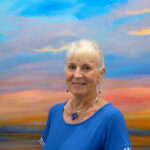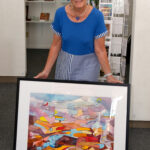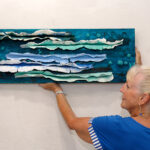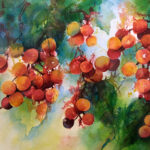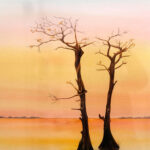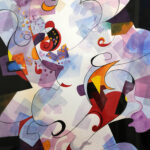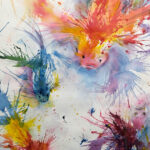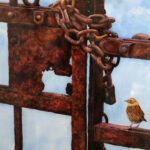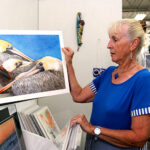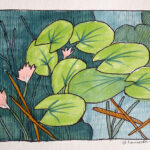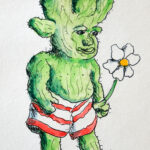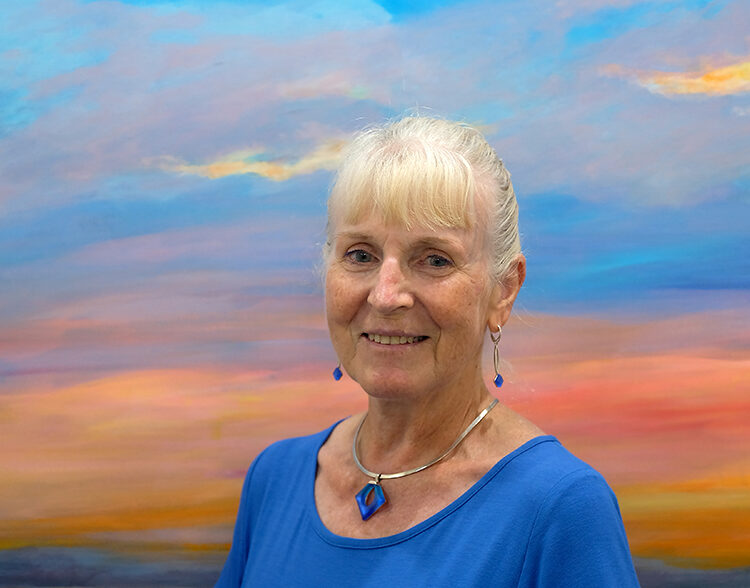
“I come from a family that somehow always practiced art,” says artist Witha Lacuesta, whose first name is pronounced “Vita.”
“My grandfather was a carriage designer and a carriage builder. Others in my ancestry were merchants, and on their travels, they also purchased paintings for their collection. My grandmother was a fashion designer in Paris as a young woman [1890]. Her brother was a sculptor, and her father painted from a young boy on,” says Lacuesta, who still has his paintings.
“My mother, father and sister were all artistic. So I painted always. As a child we went to museums on a regular basis all over Europe. We visited historic sites; the architecture introduced me to art and proportions and specific directions.”
Born in Germany, Lacuesta first came to the United States in 1967, landing in California.
“I loved California. That was when I started to live. I painted like crazy when I didn’t have to work.”
After going back to Germany to be near aging parents, she returned to the U.S. to live in Boston, where marriage, a job in cartology, and children occupied her time. Twenty-four years later, they moved to Florida.
“I am extremely happy here, but I do miss the culture of other places. In Germany, Paris was only four hours away. I love to travel.”
Lacuesta has painted professionally some 15 years, though she sold some works as far back as 30 years ago, explaining, “If someone saw and liked a painting, they could buy it, but I wasn’t focused on it as a profession then.”
Working mostly in watercolor, she has also dabbled in oils, acrylic and caustic, as well as collages and linotype, and has painted both realistic and abstract, depending on the piece. Some are combinations of mediums, such as watercolor and gold leaf.
A prolific painter, much of her work is in series, such as landscapes, historic buildings, birds, animals, flowers and street scenes. Another series is based on music and dance, whether modern or classical.
“Sometimes it’s the instrument in a piece of music that inspires me to create a certain piece,” says Lacuesta. “Sound affects me in the way I want to paint something. I am very much influenced by music. A painting based on the music Bolero, which had big sweeping movements, very slow and very exciting, but very repetitious also, was in the Festival of the Masters at Disney (a nationally recognized art festival featuring 300 award-winning artists).”
Disney chose to purchase the painting for their collection.
“People often tell me they are not really into abstracts,” says Lacuesta. “But then they look at it, and they are affected by it. People say they feel a sense of happiness and lifting when they see the music series.”
Another painting was inspired by a Mexican folk dance.
“It has a certain elegance to it, and when you see it danced, the ladies are in high heels, the man has a hat on, with a fan they use, and it is a very controlled step, very ceremonious.”
That painting was in a show, and the woman who purchased it said she owned eight dance studios.
Lacuesta often doesn’t reveal the titles of her paintings, wanting people to form their own ideas without a title influencing their perception. In that case, the woman had responded to the dance movements, even though they were abstract. It spoke to her.
Many of her dog paintings are of specific animals, their personalities shining off the paper long after they have passed on to doggy heaven. Lacuesta is also well known for her bird paintings, many of which have won awards.
“The bird population in Florida is a story in itself. I observe the animals in nature. One time I observed a turtle laying eggs and burying them. I also saw two Caracara birds watching from ‘upstairs.’ I drove around and I spotted the two birds; they had dug up the eggs. It was the young bird being taught by the adult how to find food. That is the story behind my paintings; observation, observation, observation,” says Lacuesta.
She explains that she takes photos as a reference but interprets rather than copies the background, adding, “The color composition, balance, cool/warm temperature, I always pay attention to that.”
Additionally, she carefully notes the inherent position of each animal doing its specific task.
“Young birds are very interesting because they are often awkward. To observe the story of what’s behind the bird at that moment of observation,” she explains.
“In the Blue Heron painting, it shows nest building. He is the one to choose the nesting materials and brings it to her. She either graciously accepts it or throws it overboard.”
Scenes of Old Florida, which are fast disappearing, are immortalized in her paintings, including a painting of an old gas station (since demolished) that was recognized by the children of the former owners.
Lacuesta has mastered watercolors; whether detailed or loose, it all comes together, and she achieves a balance. While many watercolorists tend toward smaller paintings, as the paint is quick drying and less forgiving than acrylic or oils, Lacuesta says she doesn’t find that a problem.
“It’s all in the way you handle it. I can paint any size watercolor,” she says, noting that as paper comes in rolls that are 6 feet by 20 feet long, she isn’t limited, although it can be challenging to find a surface large enough to lay it flat.
Another issue with large watercolors, she says, is deciding how to display them. Watercolors are generally framed under glass and the weight can get prohibitive.
“The only way to preserve something larger is to coat it and preserve it that way. It’s now admissible in art shows to do that. The traditional way was that you could not put any coating on it. We have new products to seal it, as the paper is always sensitive to moisture,” says Lacuesta.
Additionally, the way paper reacts varies depending on the manufacture and, she adds, paint behaves differently whether she is painting outdoors or in an air-conditioned space.
“I had extreme difficulty painting 2,000 feet up in the mountains, until somebody said I had to use a different paper. The paper I was using was taking up everything right away, and the other paper had another level of how it would react to the paint. This is what you have to learn if you really want to do watercolor,” she explains.
“The love of watercolor is in the flow of the pigment, what it can do, how different watercolor manufacturers change the pigment, and how it flows on different papers. You need to learn and use what the different properties are,” says Lacuesta, who has learned from experimentation as well as in classes and workshops.
“It just takes a lot of energy, and patience with yourself.” Preferring to look on the positive side of life, she says, “I can’t stop bad things from happening, but I can try to exude pleasantness and happiness, and try to assist others. That is what is really important.”
Lacuesta exhibits at the Vero Beach Art Club Gallery Annex, and at Melbourne’s Fifth Avenue Art Gallery in Eau Gallie. She has also worked in sculpture, jewelry, stage painting, linotype and monotype, and has written and illustrated a children’s story.
“I love challenges.”
Photos by Joshua Kodis

